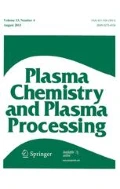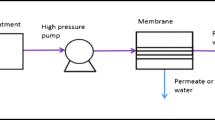Abstract
Water falling film dielectric barrier discharge (WFFDBD) has been widely studied for water treatment, due to its good performance on production of active species, mass transfer of active species from gas phase into liquid phase, and therefore the degradation of pollutants. However, few studies have focused on the production characteristics of active species of WFFDBD. In this paper, the formation characteristics of hydrogen peroxide, ozone and nitrate ions in a WFFDBD reactor powered by bipolar pulsed generator were studied under different electric discharge time, peak pulse voltage, power–frequency, air flow rate, water circulation flow rate, pH value and conductivity. The results show that the concentrations of hydrogen peroxide, ozone and nitrate ions increased with the peak pulse voltage, power supply frequency and water circulation flow rate, but the inputted air flow rate presented different effect on the production of active species. Moreover, the increase in pH value and conductivity led to a decrease in the concentration of hydrogen peroxide, while nitrate ion increased with the water pH value and conductivity. The p-nitrophenol degradation result indicates that both ozone and hydrogen peroxide contribute to its degradation possibly via their reaction into hydroxyl radical.








Similar content being viewed by others
References
Jiang B, Zheng J, Qiu S, Wu M, Zhang Q, Yan Z, Xue Q (2014) Review on electrical discharge plasma technology for wastewater remediation. Chem Eng J 236:348–368
Shang K, Li J, Morent R (2019) Hybrid electric discharge plasma technologies for water decontamination: a short review. Plasma Sci Technol 21(4):043001
Shang K, Li W, Wang X, Lu N, Jiang N, Li J, Wu Y (2019) Degradation of p-nitrophenol by DBD plasma/Fe2+/persulfate oxidation process. Sep Purif Technol 218:106–112
Shang K, Wang X, Li J, Wang H, Lu N, Jiang N, Wu Y (2017) Synergetic degradation of acid orange 7 (AO7) dye by DBD plasma and persulfate. Chem Eng J 311:378–384
Locke B, Sato M, Sunka P, Hoffmann M, Chang JS (2006) Electrohydraulic discharge and nonthermal plasma for water treatment. Ind Eng Chem Res 45(3):882–905
Guo H, Jiang N, Wang H, Shang K, Lu N, Li J, Wu Y (2019) Pulsed discharge plasma induced WO3 catalysis for synergetic degradation of ciprofloxacin in water: synergetic mechanism and degradation pathway. Chemosphere 230:190–200
Chen W, Wu H, Fan J, Fan Z, Lin S (2019) Activated persulfate by DBD plasma and activated carbon for the degradation of acid orange II. Plasma Sci Technol 22(3):034009
Zhao Y, Yao R, Meng Y, Li J, Jiang Y, Chen L (2017) The degradation of oxadiazon by non-thermal plasma with a dielectric barrier configuration. Plasma Sci Technol 19(3):034001
Cheng J, Wang D, Wang B, Ning H, Zhang Y, Li Y, An J, Gao P (2018) Plasma-catalytic degradation of ciprofloxacin in aqueous solution over different MnO2 nanocrystals in a dielectric barrier discharge system. Chemosphere 253:126595
Magureanu M, Piroi D, Mandache NB, David V, Medevedovici A, Bradu C, Parvulescu VI (2011) Degradation of antibiotics in water by non-thermal plasma treatment. Water Res 45(11):3407–3416
Yan X, Yi C, Wang Y, Cao W, Mao D, Qu Q, Shen P, Wang H (2020) Multi-catalysis of Nano-zinc oxide for bisphenol A degradation in a dielectric barrier discharge system: effect and mechanism. Sep Purif Technol 231:115897
Wu J, Wu K, Ren C, Jia P, Li X (2020) Comparison of discharge characteristics and methylene blue degradation through a direct-current excited plasma jet with air and oxygen used as working gases. Plasma Sci Technol 22(5):055505
Shang K, Wang M, Peng B, Li J, Lu N, Jiang N, Wu Y (2020) Characterization of a novel volume-surface DBD reactor: discharge characteristics, ozone production and benzene degradation. J Phys D Appl Phys 53(6):065201
Grymonpré D, Finney C, Clark R, Locke B (2004) Hybrid gas − liquid electrical discharge reactors for organic compound degradation. Ind Eng Chem Res 43(9):1975–1989
Zhang J, Chen J, Li X (2009) Remove of phenolic compounds in water by low-temperature plasma: a review of current research. J Water Resour Protect 1(2):99–109
Lukes P, Clupek M, Babicky V, Janda V, Sunka P (2005) Generation of ozone by pulsed corona discharge over water surface in hybrid gas–liquid electrical discharge reactor. J Phys D Appl Phys 38(3):409–416
Vanraes P, Ghodbane H, Davister D, Wardenier N, Nikiforov A, Verheust Y, Vanhulle S, Hamdaoui O, Vandamme J, Durme J, Surmont P, Lynen F, Ley C (2017) Removal of several pesticides in a falling water film DBD reactor with activated carbon textile: energy efficiency. Water Res 116:1–12
Krupež J, Kovačević V, Jović M, Roglic G, Natic M, Kuraica M, Obradovic B, Dojcinovic B (2018) Degradation of nicotine in water solutions using a water falling film DBD plasma reactor: direct and indirect treatment. J Phys D Appl Phys 51(17):174003
Marković M, Jović M, Stanković D, Kovacevic V, Roglic G, Gojgic-Cvijovic G, Manajlovic D (2015) Application of non-thermal plasma reactor and Fenton reaction for degradation of ibuprofen. Sci Total Environ 505:1148–1155
Yu Z, Sun Y, Zhang G, Zhang G, Zhang C (2017) Degradation of DEET in aqueous solution by water falling film dielectric barrier discharge: effect of three operating modes and analysis of the mechanism and degradation pathway. Chem Eng J 317:90–102
Dojčinović BP, Roglić GM, Obradović BM, Kuraica MM, Kostic MM, Nesic J, Manojlovic DD (2011) Decolorization of reactive textile dyes using water falling film dielectric barrier discharge. J Hazard Mater 192(2):763–771
Ren J, Jiang N, Shang K, Lu N, Li J, Wu Y (2019) Synergistic degradation of trans-ferulic acid by water falling film DBD plasma coupled with cobalt oxyhydroxide: performance and mechanisms. Chem Eng J 372:321–331
Jović MS, Dojčinović BP, Kovačević VV, Obradović BM, Kuraica MM, Gašić UM, Roglić GM (2014) Effect of different catalysts on mesotrione degradation in water falling film DBD reactor. Chem Eng J 248:63–70
Vanraes P, Wardenier N, Surmont P, Lynen F, Nikiforov A, Van Hulle SWH, Ley C, Bogaerts A (2018) Removal of alachlor, diuron and isoproturon in water in a falling film dielectric barrier discharge (DBD) reactor combined with adsorption on activated carbon textile: reaction mechanisms and oxidation by-products. J Hazard Mater 354:180–190
Sato M, Tokutake T, Ohshima T, Sugiarto AT (2008) Aqueous phenol decomposition by pulsed discharges on the water surface. IEEE Trans Ind Appl 44(5):1397–1402
Roth JR (2001) Industrial plasma engineering: volume 2: applications to nonthermal plasma processing. J Plasma Phys 68(3):237–240
Wang H, Guo H, Wu Q, Zhou G, Yi C (2016) Effect of activated carbon addition on H2O2 formation and dye decoloration in a pulsed discharge plasma system. Vacuum 128:99–105
Shang K, Li J, Wang X, Yao D, Lu N, Jiang N (2015) Evaluating the generation efficiency of hydrogen peroxide in water by pulsed discharge over water surface and underwater bubbling pulsed discharge. Jpn J Appl Phys 55(1S):01AB02
Locke BR, Shih KY (2011) Review of the methods to form hydrogen peroxide in electrical discharge plasma with liquid water. Plasma Sour Sci Technol 20(3):034006
Fridman A (2008) Plasma chemistry. Cambridge University Press, Cambridge
Lukes P, Dolezalova E, Sisrova I, Clupek M (2014) Aqueous-phase chemistry and bactericidal effects from an air discharge plasma in contact with water: evidence for the formation of peroxynitrite through a pseudo-second-order post-discharge reaction of H2O2 and HNO2. Plasma Sour Sci Technol 23(1):015019
Bradu C, Kutasi K, Magureanu M, Puaˇc N, Živkovic S (2020) Reactive nitrogen species in plasma-activated water: generation, chemistry and application in agriculture. J Phys D Appl Phys 53(22):223001
Sellers RM (1980) Spectrophotometric determination of hydrogen peroxide using potassium titanium (IV) oxalate. Analyst 105(1255):950–954
Birdsall CM, Jenkins AC, Spadinger E (1952) Iodometric determination of ozone. Anal Chem 24(4):662–664
National Environment Protection Standard of People’s Republic of China, Ambient air-Determination of ozone-Indigo disulphonate spectrophotometry, HJ 504-2009 (in Chinese)
Singh P, Singh MK, Beg YR, Nishad GD (2019) A review on spectroscopic methods for determination of nitrite and nitrate in environmental samples. Talanta 191:364–381
Liu Y, Luan J, Zhang C (2019) The adsorption behavior of multiple contaminants like heavy metal ions and p-nitrophenol on organic-modified montmorillonite. Environ Sci Pollut Res 26:10387–10397
Kirkpatrick MJ, Locke BR (2005) Hydrogen, oxygen, and hydrogen peroxide formation in aqueous phase pulsed corona electrical discharge. Ind Eng Chem Res 44(12):4243–4248
Wang J, Li L, Cao H, Yang C, Guo Z, Shi Y, Li W, Zhao H, Sun J, Xie Y (2020) Degradation of phenolic compounds by dielectric barrier plasma: process optimization and influence of phenol substituents. Chem Eng J 385:123732
Lukes P, Clupek M, Babicky V, Sunka P (2008) Ultraviolet radiation from the pulsed corona discharge in water. Plasma Sour Sci Technol 17(2):02401
Kosak-Channing LF, Helz GR (1983) Solubility of ozone in aqueous solutions of 0–0.6 M ionic strength at 5–30 degree & #xB0;C. Environ Sci Technol 17(3):145–149
Lukes P, Clupek M, Babicky V (2011) Discharge filamentary patterns produced by pulsed corona discharge at the interface between a water surface and air. IEEE Trans Plasma Sci 39(11):2644–2645
Hsieh K, Wang H, Locke BR (2016) Analysis of a gas–liquid film plasma reactor for organic compound oxidation. J Hazard Mater 317:188–197
Porter D, Poplin MD, Holzer F, Finney WC, Locke BR (2009) Formation of hydrogen peroxide, hydrogen, and oxygen in gliding arc electrical discharge reactors with water spray. IEEE Trans Ind Appl 45(2):623–629
Lukes P, Appleton AT, Locke BR (2004) Hydrogen peroxide and ozone formation in hybrid gas–liquid electrical discharge reactors. IEEE Trans Ind Appl 40(1):60–67
Sotelo JL, Beltran FJ, Benitez FJ (1989) Henry’s law constant for the ozone-water system. Water Res 23(10):1239–1246
Acknowledgements
Thanks for the support of National Natural Science Foundation of China (Grants 21577011, 51977024).
Author information
Authors and Affiliations
Corresponding author
Additional information
Publisher's Note
Springer Nature remains neutral with regard to jurisdictional claims in published maps and institutional affiliations.
Rights and permissions
About this article
Cite this article
Shang, K., Wang, N., Li, W. et al. Generation Characteristics of Long-Lived Active Species in a Water Falling Film DBD Reactor. Plasma Chem Plasma Process 41, 477–491 (2021). https://doi.org/10.1007/s11090-020-10124-9
Received:
Accepted:
Published:
Issue Date:
DOI: https://doi.org/10.1007/s11090-020-10124-9




